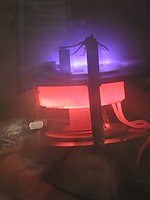
Photo from wikipedia
The increasingly complex nanoscale three-dimensional and multilayered structures utilized in nanoelectronic, catalytic, and energy conversion/storage devices necessitate novel substrate-selective material deposition approaches featuring bottom-up and self-aligned precision processing. Here, we… Click to show full abstract
The increasingly complex nanoscale three-dimensional and multilayered structures utilized in nanoelectronic, catalytic, and energy conversion/storage devices necessitate novel substrate-selective material deposition approaches featuring bottom-up and self-aligned precision processing. Here, we demonstrate the area-selective atomic layer deposition (AS-ALD) of two noble metals, Pt and Pd, by using a plasma-polymerized fluorocarbon layer as growth inhibition surfaces. The contact angle, x-ray photoelectron spectroscopy (XPS), and scanning electron microscopy measurements were performed to investigate the blocking ability of polymerized fluorocarbon (CFx) layers against ALD-grown metal films. Both Pt and Pd showed significant nucleation delays on fluorocarbon surfaces. Self-aligned film deposition is confirmed using this strategy by growing Pt and Pd on the microscale lithographically patterned CFx/Si samples. CFx blocking layer degradation during ozone exposure was analyzed using XPS measurements, which confirmed the oxygen physisorption as the main responsible surface reaction with further hydroxyl group formation on the CFx surface. Our work reveals that the CFx layer is compatible with an ozone coreactant until the blocking polymer cannot withstand oxygen physisorption. Our results could potentially be used to investigate and develop radical-assisted AS-ALD processes for a wider selection of materials.
Journal Title: Journal of Vacuum Science and Technology
Year Published: 2021
Link to full text (if available)
Share on Social Media: Sign Up to like & get
recommendations!